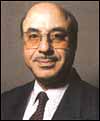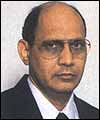CASE GAME
The Case Of Cultural
Differences
Contd.
Integrating
For Synergy
THE DISCUSSION
 ASHOK WADHWA ASHOK WADHWA
MD, Ambit Finance
Integration is critical to the success
of the merger. Sawhney can ensure this happens in two ways. He should
quickly develop a vision statement for ABB. The statement should
articulate how the new entity will position itself in relation to
customers and competitors. This should be widely disseminated. He should
also set in motion a process of absorbing the best people and the best
practices from Bradbury, all the while ensuring that the choice of the
business model and ultimate control rests with Allen. It is important to
be transparent about this process.
Simultaneously, Sawhney and his team should
review the relative strengths of both the banks (which would have been
done prior to the acquisition) and develop a coherent 5-7 year strategic
business plan for ABB. He should also put together, on a priority basis, a
core team of 100-150 senior professionals at the top-a broad mix of heads
from both Allen and Bradbury.
Sawhney should hold regular meetings with
this team to articulate, disseminate and clarify his vision for ABB. Each
senior manager will, in turn, communicate this vision to customers and
other colleagues. I'd also like Sawhney to meet large numbers of employees
and key customers.
ABB should form 5 or 6 committees of 4-5
individuals each from the senior management team. Each committee should be
asked to examine issues relating to specific aspects of the integration
process. These committees should make recommendations within two months
and, after Sawhney's concurrence, their decisions on their respective
issues should be made final and binding.
Sawhney should avoid, in the initial phase (6
months-1year), layoffs and shedding of employees except at the top level.
Every three months thereafter, he should review the performance of his
core team. At the end of a year, Sawhney should examine the progress of
consolidation and integration through the following steps:
- Reviewing the vision and its
implementation, and making adjustments and changes if necessary
(without any fundamental overhaul for at least another 2 years).
- Altering or revising the recommendations
of the integration committees in the light of any implementation
problems.
- Squeezing out synergies and cost-savings,
including rightsizing of individual businesses as required, even if it
involves difficult manpower decisions. Care should be taken to ensure
that any layoffs do not fall disproportionately on employees from
either the erstwhile Allen or Bradbury.
- Reiterating to customers and employees the
5-7 year vision for the merged entity, taking account of developments
and learnings over the first year and being genuinely sensitive to the
pain and difficulties caused by rightsizing. Finally, unifying the two
cultures into a single organisation would mean ensuring that Allen's
controls are implemented as the underlying and uncontestable framework
for the combined entity but that this is overlaid with the
relationship-focus that Bradbury brings.
 OM KAUL OM KAUL
CEO, Om Kaul Associates
Integration is a serious business.
Sawhney and the members of the management committee of Allen Bradbury Bank
must give the process of integration the attention it deserves. A separate
cell must be set up at the bank with an exclusive mandate not only to set
the ball rolling but to see the integration through to its logical end. It
is necessary to enlist the help of an outside consultant who has handled
similar assignments in the past. One of the first tasks of the cell is to
design a roadmap detailing the steps required to implement the
integration. Equally, its members must brief small groups of employees
down the line about the mechanics of integration. The cell should also
invite opinions and observations from employees. This is a confidence
building measure that will go a long way in allaying misgivings at various
levels.
A major task before the cell is to evolve a
vision for ABB. Post-merger, the matrix has changed. There are new hopes,
dreams and aspirations at the individual level. There are new objectives,
values, and differentiators at the corporate level. These must be
channelled into a common goal that inspires and energises everyone.
It is vital to retain the original strengths
of both banks-the very basis of the merger. This also means the cell
should identify the best fit for each position and each person. The merger
has changed the original paradigm and a greenfield organisation chart is
in order. This is an important step in the evolution of ABB. This apart,
Sawhney should take several other steps aimed at morale-building.
Appointing mentors who can deal with apprehensions in the minds of
employees is a good idea. Organising frequent listening-in and feedback
sessions also helps. So do out-bound programmes which can foster team
spirit. The idea is not only to reinforce the merits of the merger, but
also to listen to the voice of the people so that mid-course corrections
can be taken whenever necessary. A system of rewards and punishments
linked specifically to the goals of integration would also help.
 LEONARD D'COSTA LEONARD D'COSTA
President (HR), Piramal Enterprise
Mergers go sour when all the time and
attention at the pre-merger stage is spent sorting out technical details,
strategy, and financials. The success or failure of a merger depends on
how effectively the underlying anxieties and fears of people on both sides
are addressed-and on whether they are addressed upfront. Research shows
that over half the mergers and acquisitions done in recent times have
resulted in an erosion of market capitalisation. I suggest the following
five-point action plan.
First, Sawhney must recognize the fact that
even in a merger of equals, one side feels it has won and the other, that
it has lost. It is important to be sensitive to this factor. As part of a
focused communication programme, Sawhney must constantly reinforce the
strengths of the merger. He should put to rest the fears of job loss and
provide an assurance that the dignity and respect of the individual will
be preserved.
Sawhney should come up with a common vision
which encompasses the synergies of both organisations. The vision must
incorporate critical elements which have a strong impact on relationships.
These elements include values, attitudes and beliefs. An independent
neutral facilitator or a consultant should anchor this exercise.
With the help of the facilitator, the group
should agree on a description that would define the soundest possible
relationships in its ideal form. Many organisations try to work on hard
facts without understanding the unresolved conflicts in the minds of
employees. These conflicts pertain largely to relationship issues.
However, relationships with a high level of candor, mutual support, trust
and respect, will create a positive mindset and lead to enhanced results.
It is important at this stage that the two
groups come to a common understanding of the issues/projects at hand. The
leadership of these projects would be based on what needs to be done.
The rollout of the vision and values across
the organisation must be accompanied by the development of action plans.
Responsibilities must be clearly fixed on individuals. These action plans
should be reviewed every month by a group headed by Sawhney himself.

Readings List
Send us your solution
|

